This National Trivia Day, we’re turning to field guides and other resources to learn more about Oklahoma’s fascinating species! Challenge yourself or a friend with these 10 fish and wildlife trivia questions and find out which kind of naturalist you might be.
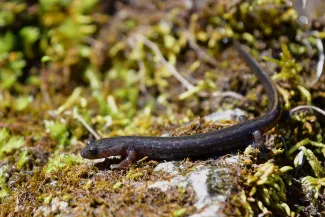
- Can you age a rattlesnake by its rattles?
Counting the number of rattles on a rattlesnake’s tail is not a reliable technique for estimating the snake’s age. Instead, rattlesnakes shed their skin as they eat and grow, adding a new rattle segment with every shed.
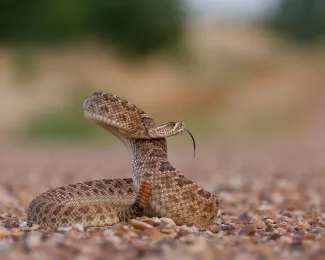 Jim Arterburn
Jim Arterburn📷 Prairie rattlesnake.
Individual snakes, especially juveniles that tend to grow quickly, may shed multiple times a year, often with unpredictable timing and frequency. Additionally, rattles may become damaged or break off between sheds. So, the number of rattles may indicate the number of times a snake has shed in its life but has no real connection to its age.
- What do Oklahoma bats eat?
Oklahoma bats eat invertebrates, especially beetles, moths, and other insects.
 Casey Evans
Casey Evans📷 Townsend's big-eared bat.
Bats use echolocation to hunt flying insects or even glean stationary insects from leaves while the bat is in flight. Oklahoma’s 20-plus bat species must either hibernate or migrate when their food source goes dormant in the fall and winter.
- What was the first reptile documented in Oklahoma by European settlers?
The first known mention of a reptile in present-day Oklahoma was of a Northern cottonmouth by Thomas Nuttall in 1819.
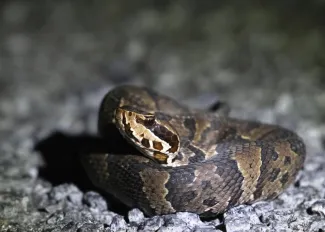 Grayson Smith/USFWS
Grayson Smith/USFWS📷 Northern cottonmouth.
In the journal describing his exploration of the territory, Nuttall wrote of a snake “…called the water-mockasin, and poisonous black-snake.” Though geographic references were limited to major landmarks, this entry appears to have been made in the vicinity of Fort Townson. Northern cottonmouths are typically found near permanent water bodies where they hunt fish, amphibians, and other prey. Several nonvenomous watersnakes are often misidentified as cottonmouths. Get tips for identifying these look-alikes in our Outdoor Oklahoma Journal.
- During which season(s) can American robins be found in Oklahoma?
American robins can be found in Oklahoma year-round.
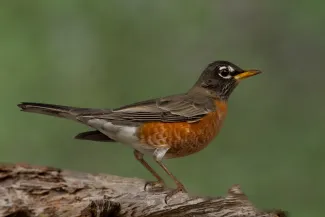 Andy Morffew/CC BY 2.0
Andy Morffew/CC BY 2.0📷 American robin.
Despite their reputation as a symbol of spring, robins are found in Oklahoma winter, spring, summer and fall. But individual robins may or may not remain in Oklahoma the entire year. Instead, birds that nested in northern regions may migrate to Oklahoma while birds that nested in the state may move further south for the winter.
Winter flocks can be quite large. In Oklahoma, a flock of approximately 100,000 robins was reported from McCurtain County in 2006 and a flock of approximately 1.25 million birds was reported in Payne County in 2008.
- Which Oklahoma frog lives most of its life in a burrow?
The crawfish frog spends much of its life in a crawfish burrow and is typically only found above ground for a 6-8-week window in late winter or early spring.
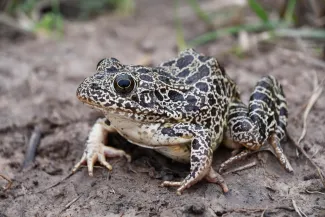 Jena Donnell/ODWC
Jena Donnell/ODWC📷 Crawfish frog.
These uniquely patterned frogs emerge from their prairie burrows when the air temperatures start to climb in February and the first spring rains begin to fall. Then, they migrate up to three-quarters of a mile to local ponds, intermittent streams, and even flooded roadside ditches where males make a distinctive snoring call to attract females. Sightings can be shared at wildlifedepartment.com or on free platforms like iNaturalist.
- Which group of Oklahoma fish has toxic eggs?
Adult gar have stout scales that serve as body armor to protect them from many potential predators, but their eggs and larvae rely on a different survival tactic – toxicity. The eggs are toxic to potential predators like mammals (including humans), birds and crayfish. Larval gar maintain the toxicity several days after hatching.
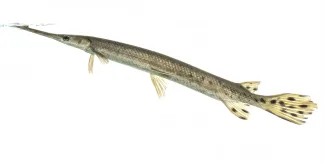 Sam Stukel/USFWS
Sam Stukel/USFWS📷 Longnose gar.
Four species of gar can be found in the state: the spotted gar, longnose gar, shortnose gar, and alligator gar, a species of greatest conservation need. Gars can survive in slower-moving, warmer waters with low dissolved oxygen levels because of their well-developed lung-like gas bladder and their ability to “gulp” for air. Such conditions are inhospitable for many freshwater species.
- What is the only vertebrate to have “Oklahoma” in its common name?
The Oklahoma salamander is the only vertebrate with “Oklahoma” in its common name.
 Jena Donnell/ODWC
Jena Donnell/ODWC📷 Oklahoma salamander.
While searching for larval fish in Adair County’s Tyner Creek in 1939, ichthyologists George Moore and R. Chester Hughes “accidentally” uncovered the first described specimens of a new species, the Oklahoma salamander. These small amphibians are only known from around gravel-bottomed streams in the Ozarks of Oklahoma, Missouri, and Arkansas, and are considered a species of greatest conservation need.
- How old was Oklahoma’s oldest known smallmouth buffalo?
Oklahoma’s record smallmouth buffalo, caught in 2019, was found to be a 62-year-old female and was thought to be the oldest known individual of its species at the time. This record was broken in 2023 when a 101-year-old smallmouth buffalo was documented from Arizona’s Apache Lake, but this fish remains Oklahoma’s oldest known smallmouth buffalo.
Image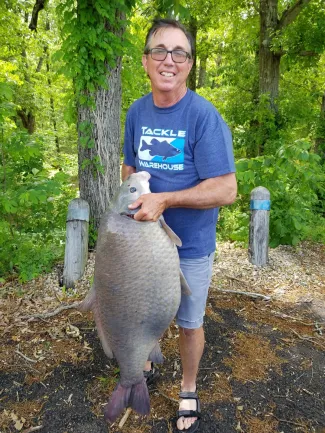
📷 Hugh Newman with a smallmouth buffalo.
To get estimates of fish age, biologists most often rely on the annual growth rings found on one of three pairs of otoliths or earstones found in each fish. After the earstones are removed from the fish, they’re sometimes browned on a hot plate to better show the contrasting annual rings, sectioned with a low-speed saw or Dremel tool, sanded with a very fine grit, and examined under a microscope. Annual rings are then independently counted by at least two trained observers to confirm the age estimate.
- How many dragonflies and damselflies have been documented in Oklahoma?
Oklahoma’s invertebrate diversity includes 176 species of dragonflies and damselflies.
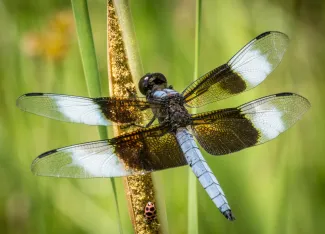 Todd Benton
Todd Benton📷 Widow skimmer.
Oklahoma ranks in the top ten of states for its odonate diversity. Our most species-rich county, McCurtain County, has more documented species than 15 states and nine Canadian provinces and territories. To build the state’s species list, biologists with the Oklahoma Natural Heritage Inventory scoured museum collections and notes from early expeditions and partnered with dedicated citizen scientists to log new records.
- What is one feather adaptation that allows owls a near silent flight?
Several feather adaptations allow owls to to fly practically without a sound. Small, comb-like serrations on the leading edge of the wing and fringe on the trailing edge muffle the “swoosh” of air moving around the wings, and the velvety surface of the wings and body helps soften the sounds of rustling feathers.
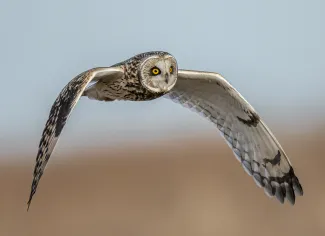 Harry Burkhalter/RPS 2021
Harry Burkhalter/RPS 2021📷 Short-eared owl.
At least 10 species of owl have been documented in Oklahoma, from the sizeable great horned owl to the tiny Northern saw-whet. Small mammals are a staple of most owl diets, but they may also eat insects, reptiles and amphibians, or even other birds.
Which Naturalist Are You?
- 8-10 correct: You’re an Outdoor Oklahoman! Consider passing wildlife trivia and tips to family, friends, or other naturalists in your community!
- 6-8 correct: You’re a seasoned naturalist!
- 0-5 correct: You may be a fledgling naturalist! Keep watching, studying, and asking questions!
With its incredible diversity of species and habitats, there’s always more to learn about Oklahoma’s natural resources. Check out our online field guide to learn about Oklahoma’s fish and wildlife, or subscribe to our monthly e-newsletter, to get research updates and ideas for getting involved in conservation.